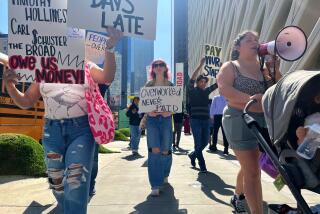In a tough economy, tips are depreciated
Jocelyne Aposaga is a hairstylist who relies on tips for about 20% of her income. As the economy slumps, she has a new survival plan: cut tips.
When Aposaga eats out, she leaves servers a buck or two less than last year. It’s not the service that’s bad, it’s the economy -- and a case of what goes around comes around.
“I am just not getting paid as much as I used to. It’s not because I am spending more money on gas or other things,” said Aposaga, who works at Aderon Salon in Pasadena.
Amid a tottering economy, rising inflation, increasing unemployment and a housing market meltdown, waiters, beauticians and pet groomers report that customers are growing tightfisted.
It is hard to determine just how much people are cutting back on tipping. But the stakes are huge.
The restaurant industry in the U.S. employs 13.1 million people, making it the nation’s third-largest employer, behind the federal government and the healthcare industry, according to the National Restaurant Assn., a trade organization.
About 1.1 million Californians work at food service and drinking establishments, many in jobs where tips make up a significant portion of their pay.
Thousands more work for car washes, nail salons, taxi companies and in other jobs in which tips play a role in their wages.
The slowdown in tips is another blow for increasingly squeezed service workers who often don’t have much of a cushion to fall back on when times get tough. Some restaurants have closed down in recent months or have begun scaling back and laying off employees.
Other industries face similar pressures.
Michael Lynn, professor of consumer behavior at the Cornell School of Hotel Administration, estimated that Americans tip $30 billion annually, although he said there have been no good studies on the issue. “But the testimony is that tips go down in bad times.”
Mac Brand, a Chicago restaurant consultant, said gratuities represent 30% to 60% of a server’s wages, and even more at upscale eateries.
“There isn’t anyone working at a chain or high-end restaurant so they can collect the minimum wage. If the tips don’t come in, it’s not worth working there,” Brand said.
California law leaves tipped workers in a better position to withstand such a downturn when compared with workers in some other states.
The state is one of seven that require employers to pay restaurant servers its full state minimum wage of $8, said Sylvia Allegretto, a labor economist at UC Berkeley’s Institute for Research on Labor and Employment.
In other states, employers generally pay only the federal sub-minimum wage of $2.13 and apply tips to make up any difference with state and federal minimum wage rules.
On a typical Saturday night, Brian Best once earned as much as $200 in tips as a server at Bubba Gump Shrimp Co. at Universal CityWalk. Since the fall, Best’s tip take has slid to about $120 on a weekend night.
“People just don’t have the money. They will go out to eat, but won’t tip as much,” Best said.
He now gets 10% to 15% of what his customers spend at the eatery, down from 15% to 20% before the economy’s nose dive.
“I am hanging out a lot less at clubs and bars. I don’t have the money,” Best said.
To boost flagging sales, some restaurants are lowering their prices and introducing more specials and discount meals. Others are scaling back portions and skimping on free items such as refills and sauces. That could lead to lower tips -- especially if customers grow upset.
At the Cask ‘n Cleaver steakhouse in Rancho Cucamonga, server Ashley Bechtel has seen a similar plunge in tips. In the Inland Empire, a troubled economic region dealing with one of the highest home foreclosure rates in the country, she said people also are economizing in other ways that cut into her pay.
“Big men will come in and order littler steaks than they used to,” Bechtel said.
Instead of purchasing the larger rib eye for $28.95, they might get the 8-ounce top sirloin for $17.95. Or patrons will come in with coupons and tip on the discounted price of their meal instead of the retail price, which is customary, she said.
Customers are spending an average of $24 per person, down from $27 in the fall, said Chuck Keagle, the chain’s owner. “Our profit is close to zero.”
Laura Hirsh, owner of Skin Care & Body Work in Sierra Madre, has tried to keep her staff from taking a double hit.
Twice a year, the spa participates in an industry promotion at which new clients can purchase expensive facials and massages for $50, well below the retail price. She posts a sign for clients to remind them that typical tips of up to 20% should be based on the regular price rather than the discounted price.
Groomers at Sparky’s Pet Salon in Los Angeles also are seeing tips fall.
Last year, about half of the people who brought their dogs to Sparky’s gave the groomers tips. But as gas and food prices surged over the past six months, that’s dropped to around 30%, said Luigi Pruve, a groomer and manager at Sparky’s.
“People who used to give us $10 give us $5. People who used to give us $5 give us just $2 or $3 or maybe nothing. We don’t ask why,” Pruve said. “There’s not much we can do.”
--
More to Read
Inside the business of entertainment
The Wide Shot brings you news, analysis and insights on everything from streaming wars to production — and what it all means for the future.
You may occasionally receive promotional content from the Los Angeles Times.











